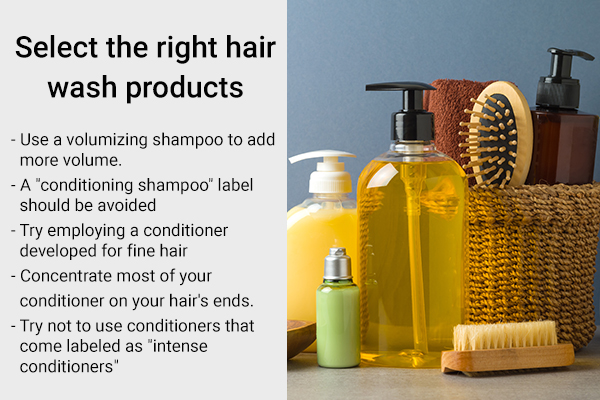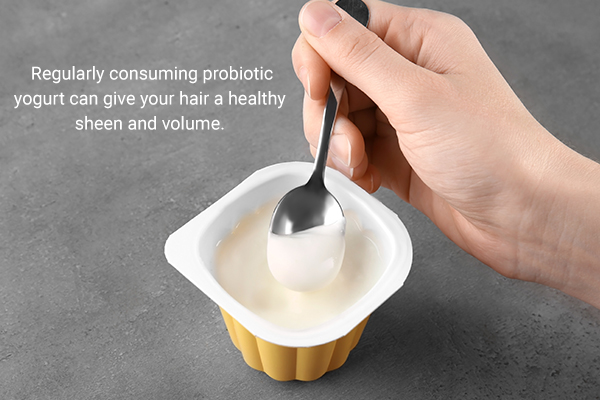In this article:
The biological cycle of hair growth is intricate. Telogen effluvium (TE) is a temporary condition marked by loss of hair that begins 3 months following a causal event.

Many stimuli, including febrile conditions, stress, major surgery, a rise in androgen and estrogen levels, and hyperthyroidism, have been linked to telogen effluvium.
Hormone levels before and after pregnancy are clearly different, according to extensive research. Human chorionic gonadotropin peaks at 2 months, progesterone gradually increases ninefold, and estrogen grows eightfold during pregnancy.
By 2–4 days after birth, progesterone and estrogen levels return to normal once the placenta is removed. Moreover, prolactin levels slowly rise throughout pregnancy, peaking at a 20-fold boost at term.
These differences in hormone levels in postpartum mothers are thought to cause TE. (1)
Fortunately, there are certain home remedies that may be helpful in dealing with postpartum hair loss.
How to Manage Hair Loss After Giving Birth
The following tips can help you manage and prevent postpartum hair loss.
1. Stay away from stress
Stress has long been considered one of the root causes of hair loss. The long-held widespread assumption that stress can have strong catagen-inducing, hair-damaging, pro-inflammatory effects has now been confirmed by in vivo research in mice.
Understanding how stress negatively affects hair development and incorporating stress-reduction techniques to control your stress, such as deep breathing, meditation, calming music, exercise, or other relaxation methods, into the treatment of hair loss disorders may result in improved therapeutic approaches that reduce clinical symptoms as well. (2)
2. Select the right hair wash products

According to the American Academy of Dermatology Association, hair loss in new moms can be dealt with by keeping the following points in mind when washing the hair: (3)
- Use a volumizing shampoo to add more volume. These shampoos frequently contain protein and other components that cover the hair strand and provide your hair with a more voluminous look.
- A “conditioning shampoo” label should be avoided because they contain thick conditioners that can make the hair look limp and can weigh it down.
- Employ a conditioner developed for fine hair as they are a lighter formulation that won’t cause your hair to clump or stick together.
- Concentrate most of your conditioner on your hair’s ends. Applying hair conditioner to the scalp can weigh your hair down.
- Do not use conditioners that are labeled “intense conditioners” as they also weigh down the hair.
3. Get a scalp massage
Research has shown that scalp massages boost blood circulation and cause an immediate stimulation of dermal papilla cells, resulting in improved hair thickness.
Authors of a study share how scalp massage can be a way of mechanically stimulating the scalp and can be a natural, effortless, and inexpensive way of facilitating hair growth rates. (4)
Pregnant women can also get head massages as they do not cause any negative effects. (5)
Here’s how to do it:
- Give your scalp a liberal coating of heated olive or coconut oil.
- Use your fingertips (not nails) to massage your head well for at least 5–10 seconds.
- The next morning, wash your hair using a soft shampoo.
- Do this at least 2–3 times a week.
4. Eat yogurt routinely

According to studies, animal models that were regularly given probiotic yogurt had improved skin and healthy, shiny, and voluminous hair. Probiotic-induced variations in hair luster were quickly observed in the female mice.
Researchers have also noted that probiotic ingestion increases hair growth. Hence, yogurt can be a part of a pregnant woman’s diet to support healthy hair. (6)
5. Give it some time!
You might be wondering, “At what point in time will my postpartum hair loss come to an end?”
Experts reassure that postpartum hair loss is not permanent. Hair loss at 4 months postpartum is somewhat ordinary for most women, and in some cases, it can prevail for some more months.
The usual hair growth generally resumes after half a year of giving birth, while some females may go on to lose their hair for around a year following childbirth.
If you think you have severe postpartum hair loss or the signs persist for more than 1 year, speak to your doctor.
6. Follow a healthy diet

Consuming a balanced diet invariably is important for maintaining health status. Hair care professionals and health experts say nutritious diets, particularly for postpartum women, can benefit overall healing and stop the advancement of postpartum hair loss.
Make sure your diet includes the right balance of nutrients, which are mostly present in fruits, veggies, and whole grains. Keep in mind to drink water often to remain hydrated.
Make your diet rich in biotin
Patients who report shedding hair may have low biotin levels. A lack of biotin can cause brittle nails, rashes on the skin, and hair loss.
Also, research has demonstrated the effects of biotin supplementation on alopecia. According to data, 50% of expectant mothers have a biotin deficiency.
Hence, to combat postpartum hair loss, a diet that includes great sources of biotin, such as eggs, yogurt, almonds, legumes, whole grains, milk, and meat, may be beneficial. (7)
Note: According to the National Institutes of Health, the recommended daily intake for biotin is 20-30 micrograms for teens and adults. (8)
7. Choose the right hair accessories and styles
Some hair accessories and styling objects can contribute to hair loss in women, including those who are new mothers. So, keeping a check on such practices and avoiding accessories that may harm the hair is important.
Some of the hair practices that contribute to hair loss are: (9)
- Using rollers at night to style your hair regularly can result in hair loss, which is why experts suggest reserving this technique for special occasions.
- Weaves and extensions can put in volume and increase the size of your hair, but they can, at the same time, cause hair loss if worn for long periods of time.
- Hairstyles that pull on your hair, such as buns and tightly pulled up-dos, should be avoided as they can contribute to hair loss. (9)
- Plastic hair ties can tug on the hair. It is better to use silk/satin hair ties and scrunchies instead.
Additional Tips to Deal With Postpartum Hair Loss

According to Lancaster General Health, the following techniques promote hair growth and keep you feeling confident. Check what works for you!
- To make your hair appear thicker, consider getting a fresh haircut (with the added bonus of less yanking from your baby).
- Be particularly gentle when washing, brushing, and styling your hair.
- Avoid wearing tight hairstyles as these will strain your hair and scalp.
- Employ lightweight conditioners and volumizing shampoos to prevent your hair from becoming weighed down (avoid products with “intense conditioning” on the label as they may cause your hair to limp).
- To guarantee that your body (and thus your hair!) is healthy, eat a balanced diet and keep taking your prenatal vitamins.
Beware of the Hair Tourniquet
If you’re a new mother who is suffering from postpartum hair loss, watch out for the clinical condition called the hair tourniquet syndrome in which a hair or thread accidentally wraps so tightly around an appendage that it causes discomfort, edema, and occasionally ischemia.
The hair strand needs to be removed right away by gently unwinding it or, if required, using scissors as it can cut off circulation.
If you require medical assistance to get the hair removed, call your doctor. (10)
When to See Doctor
A trip to your doctor might be necessary if your hair hasn’t grown back to normal after a year of giving birth. A diagnosis is necessary for appropriate therapy since other reasons can be preventing your hair from growing back or contributing to hair loss.
Most-Asked Questions About Postpartum Hair Loss
How soon after delivery does hair loss start?

According to the experts from Lancaster General Health, once your baby is born, you won’t immediately start “shedding” postpartum. Hair loss becomes visible after 3-4 months of childbirth and can happen as a surprise even when most of the postpartum signs have lessened.
You are not alone if it happens to you. Around half of all new mothers have this problem.
Can I take supplements for hair loss?
Yes, you can take supplements for deficiencies of riboflavin, biotin, folate, and vitamin B12 as they have been linked with hair loss, but it’s important to talk to a healthcare professional first. (7)
Can I use medicated shampoo/minoxidil shampoo for hair loss without a doctor’s prescription?
Medicated shampoos or minoxidil shampoos for hair loss should only be utilized with the right advice and supervision of a medical professional.
What triggers postpartum hair loss?
Postpartum hair loss is triggered by hormonal changes.
Can breastfeeding cause hair loss?
Yes, breastfeeding can cause hair loss.
What is the most promising vitamin for hair loss during breastfeeding?
Biotin is a recommended vitamin for hair loss during breastfeeding.
Can breastfeeding moms do hair treatment?
Some hair treatments may not be safe for breastfeeding moms, so it’s essential to confer with a medical professional before doing any treatments.
What are the medical treatments for postpartum hair loss?
There are no specific medications or pills that are approved by the FDA for treating postpartum hair loss. However, some healthcare professionals may recommend minoxidil lotions and biotin supplements.
Final Word
Several unanticipated physical changes can occur during pregnancy, but many new mothers are shocked by how their bodies change after giving birth, especially their hair.
Often, there is nothing to be alarmed about, and home remedies can be employed to deal with it. However, seek professional advice if the condition does not improve.
- Was this article helpful?
- YES, THANKS!NOT REALLY


